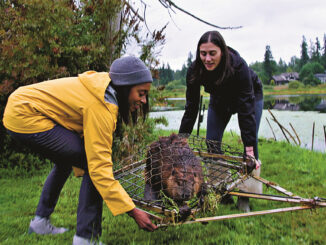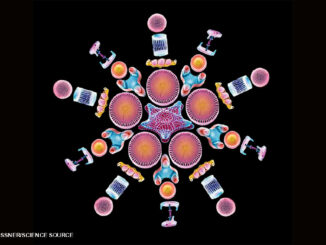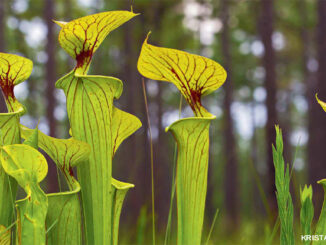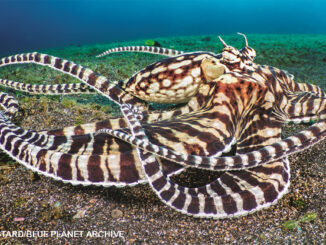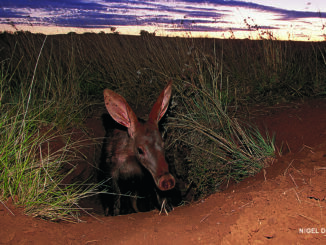
Tardigrades: Everywhere Bears
By Kathy Kranking; photos provided by Science SourceThey’re tiny. They’re tough. And they’re closer by than you might think!

The creature above looks like a gummy bear with claws! It’s called a tardigrade (TAR-duh-grayd), and that long name is actually the biggest thing about it. Most tardigrades are smaller than the period at the end of this sentence.
Tardigrades are found just about everywhere in the world—even right in your own backyard! Because they live anywhere there’s moisture and because they lumber like bears when they walk, they’re often called “water bears.”
HERE, THERE, AND EVERYWHERE
Tardigrades belong to a group of animals called invertebrates (in-VUR-tuh-bruts), animals that don’t have backbones. And with their tiny, bear-like bodies, they just might be the cutest invertebrates ever!
There are more than 1,200 species of tardigrades. They’re found from the North and South Poles to the equator, and from the highest mountains to the deepest parts of the ocean. More than half of all tardigrade species live on land, where they’re right at home in places such as lichen (LYE-ken), wet leaves, and damp moss. So whenever you’re walking in your neighborhood, a park, or the woods, chances are, hundreds of tiny tardigrades are right nearby!
AMAZING SUPERPOWERS
Even though they’re tiny, tardigrades may be the toughest animals on Earth! Scientists have put them in deep freezes more than 450° F below zero. They’ve even sent them into space, where they were exposed to high levels of radiation. But afterward, the tardigrades were just fine.
Tardigrades also have an amazing trick: When conditions get too dry for them, they curl into balls and just dry up! A dried-up tardigrade is called a tun.
As a tun, a tardigrade can survive almost anything. Scientists have put tuns in temperatures hotter than the boiling point of water. And they’ve put them under pressures that would kill other creatures. But afterward, when the tuns were soaked in water, they revived and just went about their tardigrade business! They truly are extreme survivors!

THE BEAR FACTS
A tardigrade has four pairs of legs. At the end of each leg are four to eight sharp claws, which help the tardigrade get around. A tardigrade uses the front three pairs of legs for crawling or swimming and the back pair for grasping. While many other tiny invertebrates zip around or move with jerky motions, tardigrades move along slowly. That’s how they got the name tardigrade, which means “slow stepper” or “slow walker.”
Even though these cuties have chubby, bear-like bodies, they may be most closely related to fruit flies and certain kinds of worms.
FEEDING TIME
Probably the strangest thing about a tardigrade is its “face.” It has a tube-shaped mouth that looks almost like a vacuum cleaner nozzle. Inside the mouth are sharp, needle-like parts. The tardigrade uses these to pierce mosses, algae, or other foods, then sucks the juices from them. Some species will also attack other tiny animals to eat, even other tardigrades.
INCREDIBLE EGGS
As if these animals weren’t amazing enough on their own, the eggs of some species are really cool, as well. They look more like works of art than eggs! The spikes and other “decorations” on the eggs may help them to stay put after they are laid.
Baby tardigrades break through their eggshells with their sharp mouthparts. They look just like miniature adults.
Tardigrades grow by molting, or shedding their skin, as they get bigger. A baby may molt several times before it’s full grown. Then it’s ready for life as a tiny, tough tardigrade!
GO ON A (SAFE) BEAR HUNT!
Would you like to see a tardigrade up close? The best way is by looking at it through a microscope.
If you don’t have one yourself, maybe you could use one at your school or at a nature center. A microscope that magnifies 15 to 30 times is strong enough to show tardigrades.
HERE’S WHAT YOU NEED
- paper bag or envelope
- small cup or other container
- distilled or spring water
- eyedropper
HERE’S WHAT YOU DO
- Go outside and find some moss. It could be growing on the ground or even on a tree.
- Pull up a small clump of moss. Try to get a piece with as little dirt on it as possible.
- Put the moss into the paper bag or envelope to transport it to where there is a microscope.
- Put the moss face-down into the container. Add some water to cover it and leave overnight.
- The next day, take the moss out of the container and squeeze it so that the water goes into the container.
- Use the eyedropper to suck up some water. Squirt it onto a slide, then look at it under the microscope.
You may see a number of things moving around, since tardigrades aren’t the only tiny creatures that live in moss! But soon you may spot a tardigrade. It will look barrel-shaped and move slowly, and you might be able to see its legs as it crawls along. Once you find one tardigrade, you may start recognizing others. Happy hunting!


